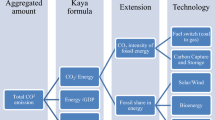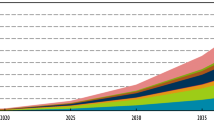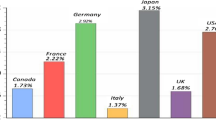Abstract
Improving the energy efficiency of conventional energy services is an essential way to cope with global CO2 emissions mitigation. To date, energy efficiency improvement (EEI) has been broadly introduced exogenously in integrated assessment models (IAMs) by virtue of the autonomous energy efficiency improvement (AEEI) coefficient; however, it is usually good at capturing the EEI driven by non-price factors, while weak in describing the EEI induced by policy incentives. In this paper, we introduce an endogenous EEI (EEEI) mechanism in an IAM, called E3METL, to explore the impacts of EEEI on the global macro-economy, CO2 emission paths, and timing of carbon mitigations. The results reveal that (1) introducing EEEI significantly improves gross world product (GWP) gains, and this positive effect is partly offset when carbon restriction policies are implemented; (2) R&D investment dedicated to enhance energy efficiency limits R&D expenditures for other alternative technologies, and this effect will impede the development of non-fossil technologies; (3) EEEI may perform as one of supporting factors to delay the actions of carbon reduction; moreover, the introduction of EEEI lowers the optimal carbon tax level by 7.8 % on average, as compared to the no EEEI case.








Similar content being viewed by others
Notes
According to Fisher-Vanden et al. (2006), around two thirds of energy-consumption changes can be attributed to price factors, while the rest (one third) comes from non-price factors. However, AEEI usually covers the energy efficiency improvement resulting from non-price factors, while captures few EEI induced by price, particularly by policy incentives, which could be largely responsible for the possible deviation.
CES method is first proposed in Arrow et al. (1961), and the general formula is Y = A(αK −ρ + βL −ρ)−1/ρ, here ρ ≤ 1and ρ ≠ 0. We could obtain two representative conclusions from this formula: first, when ρ → 0, it reduces to the classical Cobb-Douglas production function; second, the elasticity of substitution between capital stock and labor factor is constant and equals to 1/(1 − ρ).
Endogenous energy efficiency is enhanced through the substitution of knowledge capital for carbon services, and this substitution may be driven by productivity improvement of current production processes, introduction of more efficient technology, or the adoption of some carbon-control measures (Popp 2004).
Empirical studies suggest that returns to energy R&D are diminishing over time (Popp 2001). On this basis, the function form of the innovation possibility frontier should be satisfied with the following two conditions: first, ∂IPF t /∂RD ee , t > 0 and second, ∂2 IPF t /∂KDE t ∂RD ee , t < 0 (Popp 2004).
In general, C f , t /C i , t show a wide frequency distribution; hence, the ratio here means the mean value, so does the relative price P f , t (Anderson and Winne 2004).
In this work, non-carbon energy is measured by carbon ton equivalent (CTE), which can be converted in terms of the equivalent calorific value between fossil and non-fossil energy; therefore, $/tC is also employed to measure the cost of non-fossil energy (Gerlagh et al. 2003; Popp 2004).
We can observe from Fig. 5 that R&D investment on energy efficiency is several fold higher than that on non-fossil technologies. This is consistent with the reality, actually, the amount of R&D investment on new energy technologies only accounts for about 10 % of total energy R&D expenditures, which implies that nearly 90 % of energy R&D investment relates to energy efficiency improvement of conventional fuels (REN21 2015).
References
Anderson, D. (1997). Renewable energy technology and policy for development. Annual Review of Energy and the Environment, 22, 187–215.
Anderson, D., & Winne, S. (2004). Modelling innovation and threshold effects in climate change mitigation. In Working paper 59. Tyndall: Centre for Climate Change Research.
Arrow, K. J., Chenery, H. B., Minhas, B. S., & Solow, R. M. (1961). Capital-labor substitution and economic efficiency. The Review of Economy and Statistics, 43(3), 225–250.
Babonneau, F., Haurie, A., Loulou, R., & Vielle, M. (2012). Combining stochastic optimization and Monte Carlo simulation to deal with uncertainties in climate policy assessment. Environmental Modeling and Assessment, 17, 51–76.
Barker, T., Dagoumas, A., & Rubin, J. (2009). The macroeconomic rebound effect and the world economy. Energy Efficiency, 2, 411–427.
Barreto, L., & Kypreos, S. (2004). Endogenizing R&D and market experience in the “bottom-up” energy-system ERIS model. Technovation, 24, 615–629.
Bibas, R., Méjean, A., & Hamdi-Cherif, M. (2014). Energy efficiency policies and the timing of action: an assessment of climate mitigation costs. Technological Forecasting and Social Change, 90, 137–152.
Binswanger, M. (2001). Technological progress and sustainable development: what about the rebound effect? Ecological Economics, 36, 119–132.
Bosetti, V., Carraro, C., Galeotti, M., Massetti, E., & Tavoni, M. (2006). WITCH: a world induced technical change hybrid model. The Energy Journal, 27, 13–38.
Brännlund, R., Ghalwash, T., & Nordström, J. (2007). Increased energy efficiency and the rebound effect: effects on consumption and emissions. Energy Economics, 29, 1–17.
Buonanno, P., Carraro, C., & Galeotti, M. (2003). Endogenous induced technical change and the costs of Kyoto. Resource and Energy Economics, 25, 11–34.
Dowlatabadi, H., & Azar, C. (1999). A review of technical change in assessment of climate policy. Annual Review of Energy and the Environment, 24, 513–544.
Dowlatabadi, H., & Oravetz, M. A. (2006). US long-term energy intensity: backcast and projection. Energy Policy, 34, 3245–3256.
Duan, H. B., Fan, Y., & Zhu, L. (2013). What’s the most cost-effective policy of CO2 targeted reduction: an application of aggregated economic technological model with CCS? Applied Energy, 112, 866–875.
Duan, H. B., Fan, Y., & Zhu, L. (2014). Optimal carbon taxes in carbon-constrained China: a logistic-induced energy economic hybrid model. Energy, 69, 345–356.
Duan, H. B., Fan, Y., & Zhu, L. (2015). Modeling the evolutionary paths of multiple carbon-free energy technologies with policy incentives. Environmental Modeling and Assessment, 20, 55–69.
Filippini, M., Hunt, L. C., & ZoriĆ, J. (2004). Impacts of energy policy instruments on the estimated level of underlying energy efficiency in the EU residential sector. Energy Policy, 69, 73–81.
Fisher-Vanden, K., Jefferson, G. H., Jingkui, M., & Jianyi, X. (2006). Technology development and energy productivity in China. Energy Economics, 28, 690–705.
Gerlagh, R., & van der Zwaan, B. C. C. (2003). Gross world product and consumption in a global warming model with endogenous technological change. Resource and Energy Economics, 25, 35–57.
Gerlagh, R., & van der Zwaan, B. C. C. (2004). A sensitivity analysis of timing and costs of greenhouse gas emission reductions under learning effects and niche markets. Climatic Change, 65, 59–71.
Gerlagh, R. (2008). A climate-change policy induced shift from innovations in carbon-energy production to carbon-energy savings. Energy Economics, 30, 425–448.
Grubb, M., Köhler, J., & Anderson, D. (2002). Induced technical change in energy and environmental modeling: analytic approaches and policy implications. Annual Review of Energy and the Environment, 27, 271–308.
Hasanbeigi, A., Morrow, W., Sathaye, J., Masanet, E., & Xu, T. F. (2013). A bottom-up model to estimate the energy efficiency improvement and CO2 emission reduction potentials in the Chinese iron and steel industry. Energy, 50, 315–325.
Hübler, M., Baumstark, L., Leimbach, M., Edenhofer, O., & Bauer, N. (2012). An integrated assessment model with endogenous growth. Ecological Economics, 83, 118–131.
International Energy Agency (IEA) (2002). Key world energy statistic. Paris: OECD Publishing.
International Energy Agency (IEA) (2004). Renewable energy. Paris: OECD Publishing.
International Energy Agency (IEA) (2012). World energy outlook 2012. Paris: OECD Publishing.
Jaffe, A. B. (1986). Technological opportunity and spillover of R&D evidence from firms’ patents, profits, and market value. American Economic Review, 76, 984–1001.
Lin, B. Q., & Wang, X. L. (2014). Exploring energy efficiency in China’s iron and steel industry: a stochastic frontier approach. Energy Policy, 72, 87–96.
Löschel, A. (2002). Technological change in economic models of environmental policy: a survey. Ecological Economics, 43, 105–126.
Manne, A. S., & Richels, R. G. (1991). Global CO2 emission reductions: the impacts of rising energy costs. The Energy Journal, 12, 87–107.
Manne, A., & Richels, R. G. (1997). On stabilizing CO2 concentrations: cost-effective emission reduction strategies. Environmental Modeling and Assessment, 2, 251–265.
Mansfield, E. (1977). Social and private rates of return from industrial innovations. The Quarter Journal of Economics, 91, 221–240.
McKinsey and Company (2010). Energy efficiency: a compelling global resource. New York: Mckinsey & Company.
Kesicki, F., & Yanagisawa, A. (2015). Modeling the potential for industrial energy efficiency in IEA’s world energy outlook. Energy Efficiency, 8, 155–169.
Nordhaus, W. D. (1994). Managing the global commons, the economics of climate change. Cambridge, MA: MIT Press.
Nordhaus, W. D., & Boyer, J. (2000). Warming the world, economic models of global warming. Cambridge, MA: MIT Press.
Nordhaus, W. D. (2002). Modelling induced innovation in climate-change policy. In A. Grubler, A. Nakicenovic, & W. D. Nordhaus (Eds.), Technological change and environment (pp. 182–209). Washington, DC: Resources for the Future.
Pakes, A. (1985). On patents, R&D, and the stock market rate of return. Journal of Political Economy, 93, 390–409.
Popp, D. (2001). The effect of new technology on energy consumption. Resource and Energy Economics, 23, 215–239.
Popp, D. (2002). Induced innovation and energy prices. American Economic Review, 92, 160–180.
Popp, D. (2004). ENTICE: endogenous technological change in the DICE model of global warming. Journal of Environmental Economics and Management, 48, 742–768.
Popp, D. (2006). ENTICE-BR: the effects of backstop technological R&D on climate policy models. Energy Economics, 28, 188–222.
REN21. (2015). Renewables 2015 Global Status Report. Paris, France. ISBN 978–3–9815934-6-4.
Schnelder, S. H., & Goulder, L. H. (1997). Achieving low-cost emissions targets. Nature, 389, 13–14.
Schumacher, K., & Sands, R. D. (2007). Where are the industrial technologies in energy-economy models? An innovative CGE approach for steel production in Germany. Energy Economics, 29, 799–825.
Ürge-Vorsatz, D., & Metz, B. (2009). Energy efficiency: how far does it get us in controlling climate change. Energy Efficiency, 2, 87–94.
Wigley, T. M. L., Richels, R., & Edmonds, J. A. (1996). Economic and environmental choices in the stabilization of atmospheric CO2 concentrations. Nature, 379, 240–243.
World Bank. (2012). World Bank development indicator database. World Bank: Washington D C http://data.worldbank.org/indicator.
Worrell, E., Bernstein, L., Roy, J., Price, L., & Harnisch, J. (2009). Industrial energy efficiency and climate change mitigation. Energy Efficiency, 2, 109–123.
Zhang, P. (2011). The 11th five-year plan goal on energy saving has basically achieved. China Petroleum and Chemical Industry, 2, 50.
Zhou, P., Sun, Z. R., & Zhou, D. Q. (2014). Optimal path for controlling CO2 emissions in China: a perspective of efficiency analysis. Energy Economics, 45, 99–110.
Acknowledgments
Financial support for this work was provided by the Ministry of Education, Humanities and Social Sciences Youth Fund Project, No. 14YJC630029, and the National Natural Science Foundation of China under grant Nos. 71503242, 71210005. The authors would like to express their gratitude to the excellent comments from group members of the Center for Energy and Environmental Policy Research (CEEP), Chinese Academy of Sciences (CAS). Special thanks should also be given to all the anonymous reviewers for their extensive feedback.
Author information
Authors and Affiliations
Corresponding author
Appendix
Appendix
Summary of abbreviations.
- IAMs:
-
Integrated assessment models
- AEEI:
-
Autonomous energy efficiency improvement
- EEI:
-
Energy efficiency improvement
- EEEI:
-
Endogenous energy efficiency improvement
- GWP:
-
Gross world product
- R&D:
-
Research and development
- GHGs:
-
Greenhouse gases
- EU:
-
European Union
- NLP:
-
Nonlinear programming algorithm
- CES:
-
Constant elasticity substitution
- LBD:
-
Learning-by-doing
- LBS:
-
Learning-by-searching
- FBND:
-
Forgetting-by-not-doing
- CTE:
-
Carbon ton equivalent
- $/tC:
-
US dollar per ton of carbon
- BAU:
-
Business-as-usual
- CGE:
-
Computable general equilibrium
- DICE:
-
Dynamic integrated climate economy model
- ENTICE:
-
Model for endogenous technological change
- DEMETER:
-
De-carbonization model with endogenous technologies for emissions reductions
- WITCH:
-
World-induced technical change hybrid model
Rights and permissions
About this article
Cite this article
Duan, H., Zhang, G., Fan, Y. et al. Role of endogenous energy efficiency improvement in global climate change mitigation. Energy Efficiency 10, 459–473 (2017). https://doi.org/10.1007/s12053-016-9468-1
Received:
Accepted:
Published:
Issue Date:
DOI: https://doi.org/10.1007/s12053-016-9468-1




